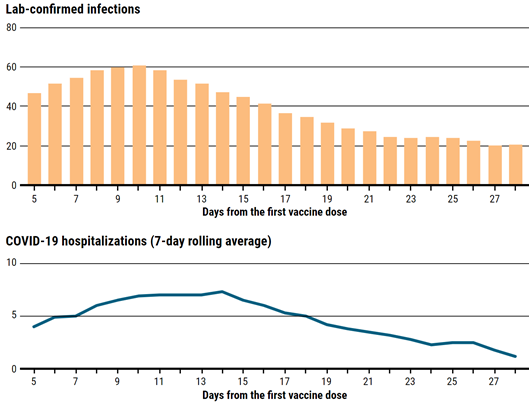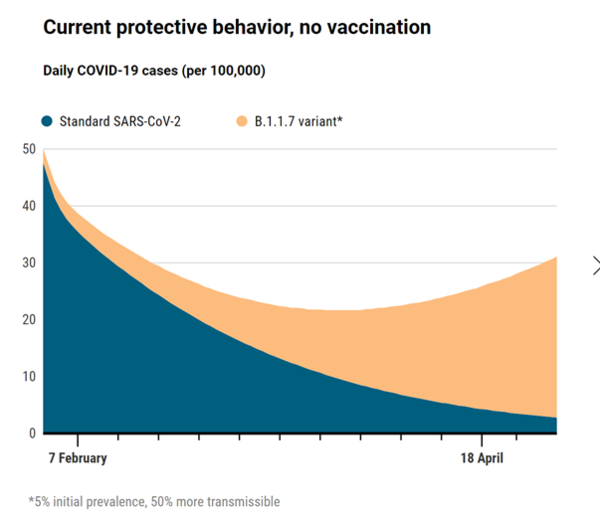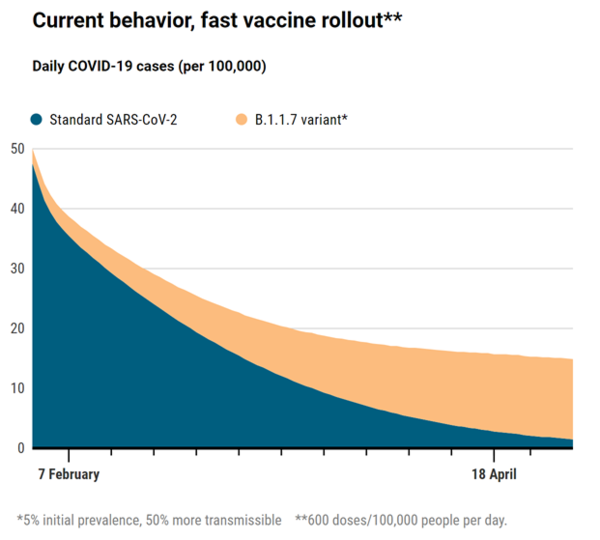(Excerpt)
More compelling, if still preliminary, evidence comes from Israel, home to the world's most aggressive and best studied immunization campaign so far. A country of 9 million people, Israel has universal health care provided mainly through four HMOs with excellent electronic medical records. The Israeli government negotiated with Pfizer to rapidly roll out its mRNA shots in exchange for sharing data about their impact with the company. Between 19 December and 4 February, 39% of Israelis had received at least one dose of the vaccine. Per capita, that is far higher coverage than in any country other than the similarly small United Arab Emirates (36%).
Nationally, COVID-19 cases and hospitalizations appear to be dropping faster among people 60 or older, the first to receive the vaccines, than among the 40- to 60-year-old segment. And in a 1 February press release, the Maccabi Research and Innovation Center--an arm of one of the four HMOs--noted it had tracked 132,015 of its members over age 60 who had received a vaccine dose in the first 9 days of the immunization campaign. Diagnosed SARS-CoV-2 infections in that group peaked about 10 days after immunizations began. By day 28, when most people had received their second, booster dose, diagnoses had fallen by two-thirds, and COVID-19-related hospitalization had dropped from a daily high of seven people to one. In the general population, the team notes, reported cases dropped much more slowly.
That finding constitutes "persuasive evidence of real-world benefit of vaccination, especially since prior behavioral restrictions in Israel did not seem to selectively protect those over 60," says Roby Bhattacharyya, an infectious disease specialist at Massachusetts General Hospital.
(Omission)
Modeler Natasha Martin and her team at the University of California, San Diego, have looked at the interplay of variants and vaccines in an even smaller area: their home county. Sequencing of COVID-19 cases in San Diego county has shown the highly transmissible B.1.1.7 variant has a 5% prevalence so far--10 times higher than recently estimated for the nation. Martin's model shows that if the variant takes over, as many researchers expect, aggressive vaccination campaigns over the next 3 months will still cut case numbers in half. But if the county drops its guard and people become lax about prevention efforts, COVID-19 cases will triple even with rapid vaccination. "We are at a critical moment in the epidemic, where our progress in terms of declining cases could quickly be reversed as the B.1.1.7 strain expands," Martin says. "We have the tools we need to fight the spread of this virus: masking, social distancing, vaccination. Now is the time to vaccinate as many people as fast as we can, and double down on masking and distancing."
(抜粋)
もっと説得力のある証拠は、まだ予備的なものではあるが、世界で最も積極的でよく調査されている予防接種運動が行われているイスラエルからのものである。人口900万人のイスラエルでは、電子カルテが充実している4つのHMOを主に通じて国民皆保険が提供されている。イスラエル政府はPfizer社と交渉し、ワクチン接種の影響に関するデータをPfizer社と共有することと引き換えに、mRNA注射の迅速な展開を求めた。12月19日から2月4日までの間に、イスラエル人の39%が少なくとも1回はワクチンを受けていた。一人当たりのカバー率は、同じように小さなアラブ首長国連邦(36%)以外のどの国よりもはるかに高い。
全国的には、COVID-19の症例と入院は、最初にワクチンを接種した60歳以上の人々の間で、40歳から60歳の層よりも急速に減少しているようだ。また、2月1日に発表されたプレスリリースでは、4つのHMOの1つであるMaccabi Research and Innovation Centerは、予防接種運動の最初の9日間にワクチン接種を受けた60歳以上の会員のうち132,015人を追跡したことを明らかにした。このグループのSARS-CoV-2感染症の診断は、予防接種開始から約10日後にピークを迎えた。ほとんどの人が2回目のブースター接種を受けた28日目までには、診断数は3分の2減少し、COVID-19関連の入院は1日に7人だったのが1人に減少した。一般集団では、報告された症例の減少はもっとゆっくりとしたものであったとチームは指摘している。
この発見は「ワクチン接種が実際に有益であることを示す説得力のある証拠である、特にイスラエルでは事前の行動制限が60歳以上の人を選択的に保護するようには見えなかったので」とマサチューセッツ総合病院の感染症専門医Roby Bhattacharyya氏は言う。
(中略)
カリフォルニア大学サンディエゴ校のモデラー、Natasha Martinと彼女のチームは、自分たちの故郷の郡というさらに小さな地域で、変異種とワクチンの相互作用を調べた。サンディエゴ郡のCOVID-19のケースのシーケンスは、感染力の高いB.1.1.7変異種は、これまでのところ5%の普及率を示しており、最近国に対して推定された値よりも10倍高い。Martinのモデルは、多くの研究者が期待するように、変異種が広がる場合は、次の3ヶ月間の積極的なワクチン接種によって症例数がまだ半分に減少することを示している。しかし、郡が油断し、人々が予防努力を怠るようになれば、COVID-19の症例数は、迅速なワクチン接種があっても3倍になるだろう。「B.1.1.7株が拡大すると、これまでの症例数の減少という点での進歩がすぐに逆転する可能性があります」とMartin氏は言う。「私たちはこのウイルスの拡散と戦うために必要なツールを持っています:マスク着用、ソーシャルディスタンシング、ワクチン接種です。今こそ、できるだけ早く多くの人にワクチンを接種し、マスク着用とディスタンシングを倍増させる時です。」
イスラエルの積極的なCOVID-19ワクチンのロールアウトは、最初に高齢者をターゲットにしており、2020年12月下旬に最初の投与を受けた60歳以上の132,015人の分析では、1ヶ月後にすでにその国のパンデミックの犠牲者を減らし始めたことを示唆している。
(図上:検査によって確定された感染数 、図下:COVID-19 入院(7日平均))

モデルによると、サンディエゴでのCOVID-19ワクチン接種の影響は、急速に普及しているB.1.1.7型によって鈍化することが示唆されており、B.1.1.7型はすでにこの地域でのSARS-CoV-2感染の5%を占めている。他の予防努力が緩和されれば、症例の急増はワクチン接種による利益を台無しにすることになるだろう。
(下図:現在の感染防止行動のまま、ワクチン接種なしの場合の10万人当たりの一日の感染者数)

(下図:現在の行動のまま、ワクチンの迅速な展開があった場合の10万人当たりの一日の感染者数)

https://www.sciencemag.org/news/2021/02/how-soon-will-covid-19-vaccines-return-life-normal